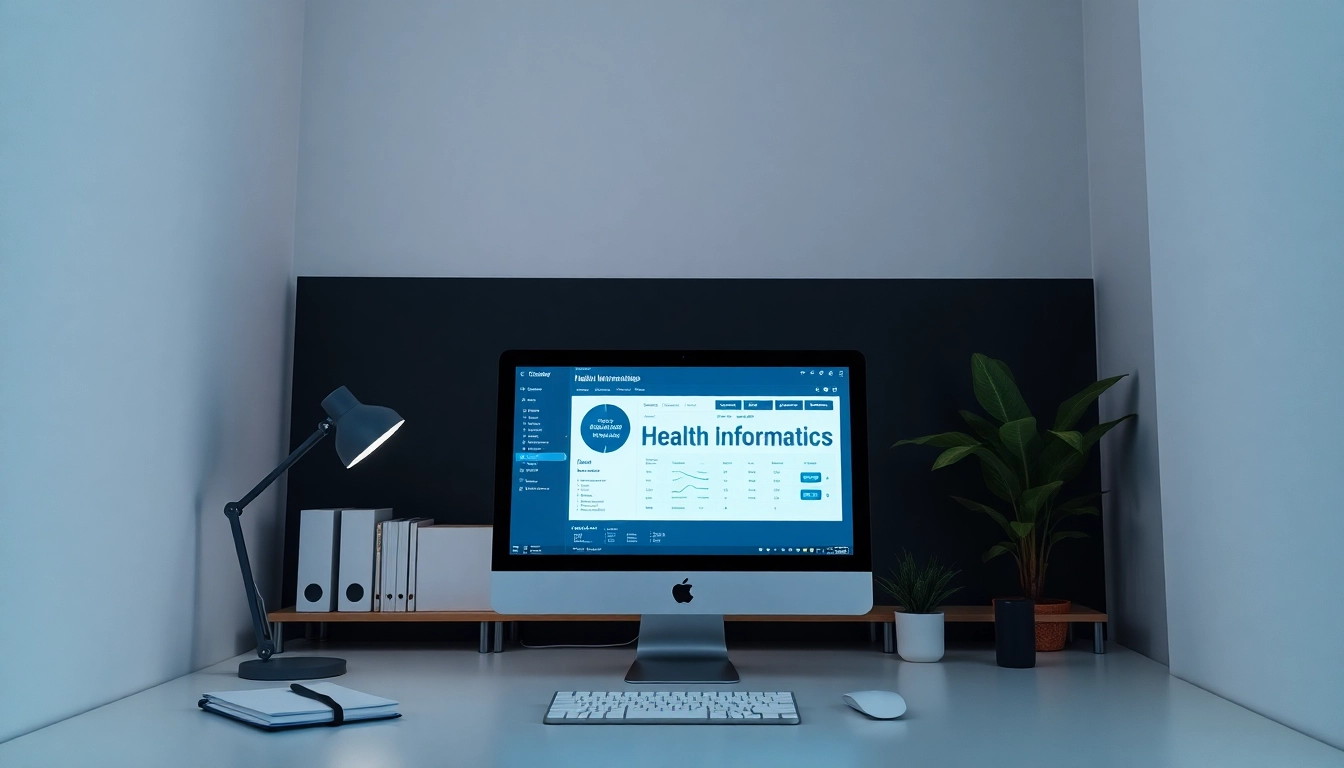Understanding Health Informatics
What is Informatics?
Informatics is a multidisciplinary field that focuses on the study and application of data, information science, and technology in various domains, especially in healthcare. It encompasses the collection, storage, processing, and dissemination of information that is critical for decision-making and problem-solving. Within healthcare, informatics aims to improve performance and delivery of patient care by leveraging data and technology to promote efficient workflows, better communication, and enhanced patient outcomes. According to the www.informaticsview.com, incorporating informatics allows health systems to analyze vast amounts of health-related data, facilitating improved treatment plans and patient engagement.
History and Evolution of Health Informatics
The roots of health informatics can be traced back to the 1960s when computers first began to be used to manage patient data. Early systems focused mainly on administrative tasks, such as billing and scheduling. However, the evolution of technology has led to significant advancements. By the 1980s, the introduction of electronic health records (EHRs) marked a revolutionary shift in the way health information was documented and exchanged. The 1990s saw the establishment of health informatics as a recognized discipline, largely propelled by the increasing complexity of patient care, the rise of the internet, and a growing emphasis on data-driven decision-making. Achievements in this realm have paved the way for contemporary systems that integrate artificial intelligence, machine learning, and telemedicine into healthcare.
Importance of Informatics in Modern Healthcare
In today’s healthcare landscape, informatics plays a crucial role in enhancing the quality and efficiency of care provided to patients. By utilizing data analytics, health informatics enables providers to make informed clinical decisions that significantly improve patient outcomes. Improved data management and interoperability among different systems foster better communication amongst healthcare professionals, promoting collaborative care. Additionally, with the rise of telehealth, informatics is indispensable for monitoring patient health remotely, ensuring timely interventions based on real-time data. The transformation has not only improved patient care but also made healthcare systems more accountable, responsive, and efficient.
Applications of Informatics in Healthcare
Electronic Health Records (EHRs) and Their Benefits
Electronic Health Records (EHRs) are one of the most noteworthy applications of informatics in healthcare. EHRs serve as a digital version of patients’ paper charts, providing real-time, patient-centered records that are accessible to authorized users. The benefits of EHRs are multifaceted:
- Improved Patient Care: EHRs centralize patient data, allowing for comprehensive access to patient histories, medications, allergies, and test results, which enhances clinical decision-making and reduces the risk of errors.
- Efficiency Gains: By automating administrative tasks, EHRs streamline workflows, allowing healthcare professionals to spend more time on patient care rather than managing paperwork.
- Enhanced Communication: EHRs facilitate secure sharing of information among different healthcare providers, which is essential for coordinated care, especially when multiple specialists are involved.
- Data Analysis: EHRs provide the capability to analyze patient data trends, outcomes, and treatment effectiveness, contributing to quality improvement initiatives.
Clinical Decision Support Systems (CDSS)
Clinical Decision Support Systems (CDSS) are critical tools that utilize patient-specific data to assist healthcare providers in making clinical decisions. CDSS can provide alerts and reminders for preventive care, medication interactions, or abnormal laboratory test results. The integration of CDSS within clinical practice has shown to enhance patient safety and care quality. For instance:
- Improved Diagnostic Accuracy: CDSS can analyze patient data in conjunction with clinical guidelines, aiding providers in making more accurate diagnoses.
- Evidence-Based Recommendations: Through algorithms and databases, CDSS offers evidence-based protocols tailored to individual patient needs, enhancing treatment adherence.
- Cost Efficiency: By preventing unnecessary tests and procedures, CDSS contributes to lowering healthcare costs while maintaining high-quality care.
Telemedicine and Its Role in Patient Care
Telemedicine has emerged as a vital application of informatics, enabling healthcare providers to deliver services remotely. It capitalizes on modern communication technology to facilitate consultations between patients and providers without geographical constraints. The importance of telemedicine includes:
- Increased Accessibility: Telemedicine breaks down barriers to care, especially for patients in rural or underserved areas, who may lack immediate access to healthcare facilities.
- Convenience for Patients: Patients can consult with healthcare providers from the comfort of their homes, reducing travel time and associated costs. This flexibility can lead to increased engagement and adherence to treatment plans.
- Streamlined Care Coordination: Telemedicine supports better communication among healthcare teams, improving the quality of care delivered while reducing the potential for mistakes.
Challenges in Implementing Informatics Solutions
Data Security and Patient Privacy
With the increasing use of digital health records and interfaces, data security has become a paramount concern for healthcare organizations. Protecting sensitive patient information from breaches, unauthorized access, and cyberattacks is essential. Organizations must comply with regulations such as HIPAA (Health Insurance Portability and Accountability Act) to ensure patient privacy. To address data security challenges, healthcare providers can implement:
- Robust Encryption: Using advanced encryption methods for data transmission and storage can safeguard sensitive information from unauthorized access.
- Regular Security Audits: Conducting frequent security assessments can identify vulnerabilities and ensure compliance with regulations.
- Employee Training: Educating healthcare staff about data privacy principles and best practices can mitigate the risk of accidental breaches.
Interoperability Issues among Systems
The integration of various health information systems is crucial for delivering seamless care. However, interoperability remains a significant challenge. Many healthcare providers use disparate systems that do not communicate effectively, leading to fragmented care. To combat this issue, organizations can invest in:
- Standardized Protocols: Adopting widely accepted data exchange standards like HL7 and FHIR (Fast Healthcare Interoperability Resources) can enhance the compatibility of systems.
- Collaborative Initiatives: Collaborating with vendors, government agencies, and industry stakeholders to develop interoperable solutions can lead to improved data sharing.
- Continuous Evaluation: Regularly assessing technology needs and system capabilities can help organizations adjust and improve interoperability long-term.
Training Healthcare Professionals Effectively
The successful implementation of health informatics solutions is contingent upon the proficiency of healthcare professionals. However, many providers lack the necessary training and expertise to effectively utilize these systems. To enhance training:
- Ongoing Education Programs: Investing in continuous professional development ensures staff remains updated on the latest informatics tools and practices.
- Mentorship Programs: Pairing experienced informatics professionals with junior staff can provide real-world insights and foster knowledge transfer.
- User-Centered Training: Tailoring training programs to the specific needs and workflows of different healthcare roles can improve adoption and effectiveness.
The Future of Informatics in Healthcare
Emerging Technologies in Health Informatics
As healthcare evolves, so do the technologies that underpin health informatics. Emerging technologies are poised to reshape the landscape of healthcare delivery significantly. Notable advancements include:
- Artificial Intelligence (AI): AI tools can analyze vast data sets to uncover insights, automate repetitive tasks, and even assist in clinical decision-making with predictive modeling.
- Blockchain Technology: Blockchain has potential applications in securing patient data, enabling transparent transactions, and improving interoperability among disparate systems.
- Wearable Technologies: Devices that track patient health metrics in real time can provide clinicians with continuous data, enabling proactive healthcare interventions.
Predictive Analytics and Decision-Making
Predictive analytics further extends the capabilities of informatics by using historical data to forecast outcomes and improve clinical decision-making. By identifying patterns and trends in patient data, healthcare organizations can proactively manage patient care. Benefits include:
- Risk Assessment: Predictive models can identify high-risk patients, facilitating earlier interventions and personalized treatment plans.
- Resource Optimization: Anticipating patient needs allows for more efficient allocation of resources, improving service delivery.
- Enhanced Patient Outcomes: By leveraging predictive analytics, organizations can track effectiveness and adjust treatment strategies effectively.
Patient-Centric Approaches Powered by Informatics
The future of informatics will emphasize patient-centered care. With patients increasingly empowered to engage in their healthcare journey, informatics initiatives will seek to provide tools that facilitate greater involvement. Examples include:
- Patient Portals: These platforms allow patients to access their medical records, communicate with providers, and manage appointments, fostering individual engagement in health management.
- Telehealth Services: By providing virtual care options, patients can more readily access healthcare resources tailored to their schedules and needs.
- Personalized Health Plans: Informatics can support the development of individualized healthcare plans based on patients’ unique health data and preferences, improving adherence and satisfaction.
How to Leverage www.informaticsview.com for Growth
Resources Available for Healthcare Professionals
www.informaticsview.com serves as a valuable resource for healthcare professionals striving to enhance their knowledge and explore the field of health informatics. The site houses a wealth of information, including:
- Research Publications: Access to peer-reviewed studies and papers that delve into various subfields of health informatics.
- Case Studies: Real-world examples of successful informatics implementations that provide insights and lessons learned.
- Webinars and Tutorials: Educational content to help professionals stay updated with technological advancements and best practices in informatics.
Networking Opportunities in the Informatics Community
Engagement with the informatics community is essential for personal and professional growth. www.informaticsview.com provides networking opportunities through:
- Online Forums: Platforms for professionals to discuss challenges, share experiences, and collaborate on projects.
- Professional Organizations: Resources for connecting with local and national informatics groups for mentorship, collaboration, and professional development.
- Conferences and Events: Information on upcoming conferences and workshops that provide opportunities to learn and network with industry experts.
Guidelines for Continued Learning in Health Informatics
To remain competitive in the dynamic field of health informatics, continuous learning is critical. Professionals should consider the following guidelines:
- Staying Current with Trends: Regularly read industry publications and follow relevant blogs to keep abreast of the latest developments.
- Pursuing Certifications: Attaining certifications in health informatics can help validate expertise and professional capabilities.
- Engaging in Research: Contributing to research projects can deepen understanding and foster innovation in informatics practices.



